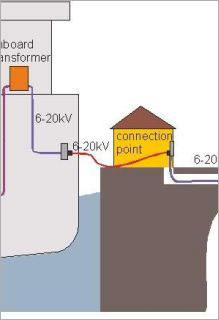What is OPS?

Onshore power supply (OPS) is one of the strategies recommended by the World Port Climate Initiative for reducing the environsmental impact of seagoing vessels in ports.
OPS replaces auxiliary engines at berth
When berthed, ships require electricity to support activities like loading, unloading, heating and lighting and other onboard activities. Today, this power is generally provided by auxiliary engines that emit carbon dioxide (CO2) and air pollutants, affecting local air quality and ultimately the health of both port workers and nearby residents. The same holds for noise nuisance.
As an alternative to onboard power generation, vessels can be hooked up to an onshore power supply, i.e. connected to the local electricity grid. In this way ships’ operations can proceed uninterrupted, while eliminating negative side-effects.
Increased focus on OPS
Ports nowadays are not normally equipped to supply vessels with electricity from the dockside, nor are vessels usually equipped to receive power in this way. Around the world, though, many activities in this direction are now underway and interest in the technology is rapidly growing, spurred on by tougher environmental legislation, greater focus on emissions in ports from shipping, and, more recently, rising fuel prices.
Cost-effective implementation of the technology requires collaboration among a wide range of stakeholders at an early stage, when planning new quays and ordering new vessels, for example.
More information on the influence of voltage and frequency differences and the differences in electricity producing methods are available via the submenus on this page.
Click here to find out more about the possibilities of OPS implementation in your own port.